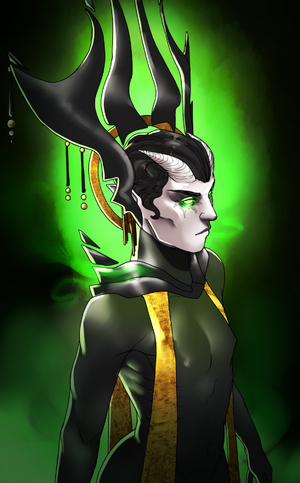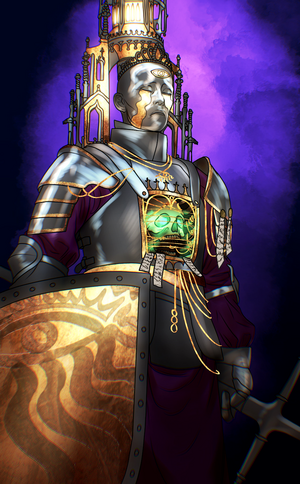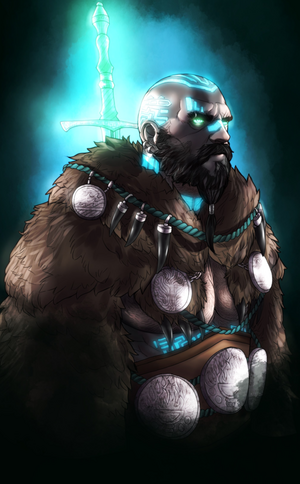More actions
The stuff of nightmares for some, figments of folklore for others, and the steadfast guardians of ancient faith to even fewer, Undead are a barely understood Affliction that has started wreaking havoc in Aloria in the past century or so, leaving scholars unable to figure out why. Undead take a variety of different forms, often dictated by the faith and belief they held in life as they are barred from the gates of the afterlife, but they share a common trait in being damned by the living for their very existence is a revolt against nature and the cycle of life and death. Playing Undead is not recommended for new players, or for long-term goals. Undead Characters are hated by nearly all cultures and Religions and have very limited roleplay opportunities. When playing an Undead, choose one of the Undead Types, and follow the rules defined. It is possible to both make a new Character that was made Undead in their backstory, as well as convert an existing Character into an Undead. However, in such an instance, the body must not be held by the state.
Undead Types
There are three Types of Undead, Deathveil Undead who are the more general type of Undead, Relicsworn Undead who are distinctly Unionist aligned, and Godsrot Undead who are Fornoss Religion aligned, each with differing legality.
Deathveil Undead
 |
Description |
Deathveil Undead are created in circumstances that are not understood but are likely due to the interference of Ordial Entities like the Death Gods Malefica, the Consigner, or the Machinist. An Undeath occurs when a person's soul is unable to pass on into the afterlife, and is somehow condemned to remain with their body. Deathveil Undead are usually created by the Death Gods to do their bidding in their war on the living and to consume their souls. Within many societies and religions, Undead are also an abomination, especially so in Regalia, where Undead have been a continuing menace. Deathveil Undead are the most common form of Undead, who are generally universally hunted by all law-abiding citizens, religious forces, and military organizations. Only the most outcast of criminals and low-lives might tolerate Deathveil Undead, who are generally only somewhat safe existing in the Sewers. Many Deathveil Undead are either willing or unwilling soldiers of the Malefica, thus considered evil. While is possible for a Deathveil Undead to wish freedom from the clutches of the Ordial entites that control them, this is usually not up to them, and thus they are still complicit in the actions of their masters. It is not possible for a Deathveil Undead to become mortal, or to have their body/soul reinstated. They can however be made Spirits by other entities such as Gods, Arken, Ordial Entities, or Dragons (via Archon). |
| Rules |
| |
| Mechanic 1 |
Deathveil Undead no longer need biological processes such as breathing, eating, or sleeping. They are theoretically immortal so long as their body is not physically destroyed, as destroying their head will still force their soul to detach from their body and pass on. Deathveil Undead can live for hundreds of years, though we recommend a maximum of 500, due to the stringency of lore from this far back. | |
| Mechanic 2 |
Deathveil Undead, due to their connection with the Ordial Gods Malefica, the Consigner, and the Machinist, are able to use Divinium to summon these entities, even if normally Pagan or Cult Gods such as these could not be summoned. In doing so, not only do they have access to the normal Divinium Summoning, these entities also double as having all functions of the Spirit Dukes. | |
| Mechanic 3 |
Deathveil Undead do not need to remain bodily cohesive, meaning parts of them can live independently from the main body. This could for example allow them to send a hand crawling under a doorway which can later be re-attached, or an eye held around a corner to see. This allows Deathveil Undead to creatively interact with some Staff Events by creatively using their bodily flexibility. |
Relicsworn Undead
Godsrot Undead
Expanded Lore
Expanded Lore offers more reading material regarding the Undead or Undeadism in general, but is not required reading in order to get a decent experience.
Perception of Death
To most Religions of Aloria, Undeath is a perversion of faith, because most faiths have the principle of divine judgement, where a person's soul shall be judged by a God of the afterlife, and deemed worthy to paradise. The logic that many faithful uphold, is that any type of Undead they meet, must have been rejected by their God and is therefor an immoral and sinful being, or one who actively wanted to avoid the judgement of their God and thus commit blasphemy. The reality is more complicated however, as the vast majority of the Undead did not ask to become Undead, or worse, were forced into by other more nefarious individuals. Undeath has only really become a major problem in the last 40 years with the rate of Undeath exploding exponentially each year. Undeath has existed for as long as death and life were a thing on Aloria, with references found even in Seraph murals, but it was always a fringe issue, until the gruesome murders at the Imperial Palace that saw all the sons of Emperor Justinian II slain by an outbreak of Undeath in the Palace itself. Since then, most faiths and societies have adopted anti-Undeath burial practices, like cremation and beheading before burial (the latter of which prevents Undeath from ever taking place).
Undead around the world
While Relicsworn Undead are usually limited to Regalia or Etosil and Godsrot Undead are exceedingly rare, Deathveil Undead can be found all over the world in all manner of cultures. In Elven and Estelley society, a type of Deathveil Undead called Deathwatch is common where living bodyguards are forced to become Undead through a ritual act, which binds them into service to their master's family for all eternity. The Deathwatch Undead push away the influence of the Death Gods by killing and offering them the souls of their enemies to consume, thus sating their desire for death and preventing them from controlling the actions of the Deathwatch. The Saydir are Undead sand-wraiths from Ard al Nur (the homeland of the Qadir and Songaskians). The Saydir were originally the Sariyd inhabitants who were swallowed by the Great Storm and choked out. Though, because this event also had the corrosive influence of the Death Gods, many of these Sariyd citizens would become Undead in their rage against the Dragons. Saydir continue to be a massive problem to both the Qadir and Songaskians, as they reside in large numbers in the desert dunes, and make the nights in Ard al Nur extremely dangerous.
Necromancy
The concept of Necromancy or Death Magic exists in Aloria, but is has nothing to do with Undead. Undeath purely describes the concept of a soul bound to its body after having departed from it partially, but being unable to pass on fully. Necromancy or Death Magic describes the act of animating dead tissue or objects through Magic, or by the use of Spirit (Shades). Necromancers cannot control the bodies of Undead, and Undead also cannot act as fuel for Necromancers. The souls used for Necromancy (Shades) and the souls still attached to Undead bodies (normal souls) are also vastly different, though Undead Necromancers do exist, especially Deathveil Undead. Deathveil Undead, being close to the Malefica, can command a great deal of control over other Ordial-aligned aspects, such as Death Magic and Shades themselves. This is of course dependent on the Undead embracing the Malefica and its hatred against the living. The Malefica does not grant the gifts of the Beyond to the Undead who only reluctantly work for the Death Gods in their quest to cause death and end the concept of life.
Trivia
- A rumor for nearly two decades after it happened was that the Emperor couldn’t bear to kill his last remaining son, despite his Undead status. Instead, he kept him chained and secured away in the deepest reaches of the Imperial Palace.
- In places where necromancy is either legal or looked over, some necromancers turn a very healthy profit by resurrecting the dead pets of the wealthy who can’t bear to be parted from their favorite companions. It should be noted however, that these pets are not Undead, but rather Ordial Shades forced into corpses as Spirits.
- With the rise in publicity of knowledge about Ordial powers and Deathveil Undead, so too has the paranoia of those who hate them risen, leading the most radical of conspiracy theorists to believe that the Regalian Empire may be entirely controlled by phantom-possessed people or Undead high priests and bureaucrats.
| ||||||||||
| Accreditation | |||||||
|---|---|---|---|---|---|---|---|
|
| ||||||

